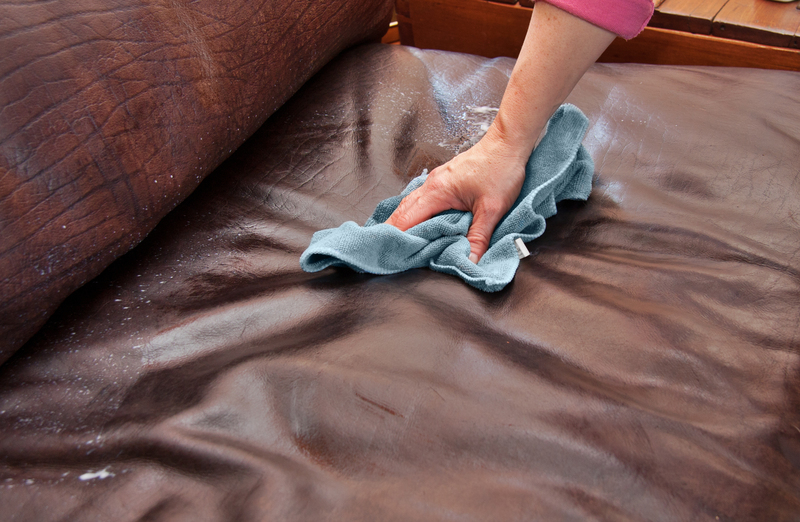The Indispensable Role of Air Quality in Home and Business Settings
Posted on 25/06/2025
The Indispensable Role of Air Quality in Home and Business Settings
Clean air is the cornerstone of a healthy, productive environment. Whether at home relaxing or at work aiming for peak performance, the quality of indoor air profoundly influences our health, comfort, and overall well-being. Yet, many tend to overlook its importance--despite scientific research repeatedly emphasizing its critical role. In this comprehensive article, we'll examine why air quality is crucial in homes and businesses, uncover its far-reaching effects, and explore actionable strategies to improve and maintain it for a safer, healthier indoor environment.

Why Is Indoor Air Quality So Important?
Indoor air quality (IAQ) is the measure of pollutants, particles, and other contaminants present in the air inside a building or enclosed space. On average, people spend over 90% of their time indoors--at home, work, or other indoor venues. According to the Environmental Protection Agency (EPA), indoor air can be up to five times more polluted than the air outdoors. The hidden dangers lurking in the air we breathe can cause a multitude of health effects, impacting not just comfort but also long-term wellbeing and productivity.
Key Benefits of Good Air Quality
- Improved Health & Reduced Illnesses: High-quality indoor air reduces respiratory issues, allergies, asthma attacks, headaches, and even serious health conditions like heart disease or cancer due to long-term exposure to harmful pollutants.
- Enhanced Productivity & Cognitive Function: Cleaner air leads to better concentration, focus, and mental clarity--vital for both students at home and employees in office settings.
- Better Sleep Quality: Poor air quality can negatively affect sleep by increasing the likelihood of breathing problems or discomfort at night.
- Lower Healthcare Costs: By minimizing allergies and chronic illnesses, you're not just improving lives--you save on medical bills and sick days.
- Equipment Longevity: Especially in business contexts, cleaner air prevents premature wear and inefficiencies of sensitive machinery, electronics, and HVAC systems.
Common Indoor Air Quality Challenges
Several factors contribute to indoor air pollution in homes and businesses. Identifying and addressing these is key for maintaining optimal air purity levels.
Key Indoor Air Pollutants and Sources
- Particulate Matter (PM): Fine dust, smoke, pollen, pet dander, and airborne particles.
- Volatile Organic Compounds (VOCs): Emitted from paints, cleaning agents, air fresheners, building materials, and furniture.
- Mold and Mildew Spores: Caused by excess moisture, often found in bathrooms, kitchens, and basements.
- Carbon Monoxide (CO) and Carbon Dioxide (CO2): From fuel-burning appliances, vehicles, and human respiration.
- Biological Contaminants: Dust mites, bacteria, viruses, and pet hair.
- Radon Gas: A naturally occurring radioactive gas which can enter buildings through cracks in foundations.
- Tobacco Smoke: Contains thousands of harmful chemicals and fine particles that linger indoors.
Other Contributing Factors
- Poor Ventilation: Insufficient airflow allows pollutants to accumulate.
- Humidity Imbalances: Both high and low humidity can trigger health problems and facilitate pathogen growth.
- Neglected HVAC Systems: Dirty filters and ducts become breeding grounds for contaminants.
- Renovations and New Construction: These introduce extra dust, chemicals, and off-gassing materials.
Health Effects of Poor Indoor Air Quality
Exposure to polluted indoor air can have immediate and long-lasting health consequences. Symptoms of poor air quality may include:
- Short-term effects: Eye, nose, and throat irritation; headaches; fatigue; dizziness; aggravated asthma symptoms.
- Long-term effects: Chronic respiratory diseases, cardiovascular disease, decreased lung function, and increased risk of certain cancers.
Children, elderly people, and individuals with existing health conditions are particularly vulnerable to low air quality in indoor environments.
Air Quality in Home Settings: Ensuring a Healthy Living Environment
Home should be a sanctuary. Yet, sources like cooking, cleaning supplies, pets, hobbies, and building materials may compromise the quality of air in your living spaces.
Strategies to Improve Air Quality at Home
- Ensure Proper Ventilation: Open windows when possible and use exhaust fans in bathrooms and kitchens to remove moisture and fumes.
- Control Humidity Levels: Use dehumidifiers in damp areas and maintain indoor humidity between 30-50% to prevent mold growth and dust mites.
- Use HEPA Air Purifiers: High-efficiency particulate air filters capture fine particles, allergens, and pollutants effectively.
- Keep the Home Clean: Regular vacuuming (with HEPA-equipped cleaners), mopping, and dusting helps remove contaminants like dust, pollen, and pet dander.
- Reduce Use of Harsh Chemicals: Opt for natural or certified 'green' cleaning products, avoid air fresheners, and allow new furniture or paint to off-gas in a ventilated area.
- No Smoking Indoors: Make your home a smoke-free zone to dramatically improve indoor air conditions.
- Monitor for Radon and Carbon Monoxide: Install detectors and test your home periodically, especially in basements or older constructions.
- Maintain HVAC Systems: Change filters regularly and consider professional cleaning of air ducts and vents.
- Add Houseplants: Some indoor plants naturally help filter certain toxins from the air (though they are not a substitute for proper ventilation or filtration).
By implementing these practices, households can enjoy fresher, healthier air, leading to a noticeable improvement in quality of life and well-being.
Air Quality in Business Settings: The Silent Factor in Productivity and Profitability
Offices, retail spaces, warehouses, and other commercial settings have unique challenges and responsibilities regarding air purity. Business owners and facility managers must safeguard employee and customer health while also ensuring operational efficiency.
Why Businesses Must Prioritize Air Quality
- Employee Health and Attendance: Good air quality lowers absenteeism caused by allergies and sick building syndrome. Healthier employees are more engaged and productive.
- Legal and Regulatory Compliance: Many regions have regulations on indoor air standards for workplaces. Failure to comply can result in fines or litigation.
- Brand Image and Customer Retention: Clean, pleasant air creates a positive impression and can make customers stay longer and return often.
- Preservation of Products and Equipment: Sensitive electronics, artworks, or foodstuffs often require careful humidity and pollutant control.
- Employee Morale and Satisfaction: Comfortable, fresh environments contribute to higher job satisfaction and lower turnover.
Best Practices for Improving Air Quality in Business Environments
- Upgrade Ventilation Systems: Invest in modern HVAC with advanced filtration and proper fresh air intake.
- Regular System Maintenance: Change filters as recommended, clean ducts, and ensure proper operation of exhaust fans.
- Monitor CO2 Levels: High carbon dioxide concentrations lower alertness and productivity. Install CO2 sensors in densely populated rooms and increase ventilation as needed.
- Control Pollutant Sources: Restrict chemical storage to well-ventilated, isolated areas, and use low-VOC paints and materials during renovations.
- Use Air Purification Technologies: Deploy air purifiers or UV-C sanitizers especially in high-traffic or high-risk areas.
- Educate Staff: Train employees about air quality practices, emergency protocols, and encourage prompt reporting of leaks or mold growth.
- Implement Green Building Strategies: Consider LEED certification or similar programs emphasizing holistic air quality solutions.
By making air quality a strategic priority, businesses can reap improved operational efficiency, reduced costs, and greater employee and customer satisfaction.
The Role of Professional Air Quality Testing
To accurately assess the condition of indoor air, homeowners and businesses should consider professional air quality testing. Certified specialists use advanced equipment and methodologies to detect and quantify pollutants such as VOCs, mold, allergens, CO2, CO, and particulates.
Benefits of Air Quality Assessments
- Identifies Hidden Threats: Many pollutants are colorless and odorless, making professional assessment essential for early detection.
- Custom Tailored Solutions: Reports allow for pinpointed remediation and improvement strategies rather than generalized approaches.
- Clear Baseline for Improvement: Track air quality over time to evaluate intervention success.
- Supports Compliance: Especially critical for businesses needing to demonstrate adherence to workplace safety regulations.
Following a professional evaluation, experts may recommend additional measures such as installing higher grade filters, repairing leaks, mold abatement, or modifying air handling systems.
Technologies That Enhance Indoor Air Quality
Advances in technology have introduced innovative tools and equipment for monitoring and improving inside air quality. Here are some of the most effective modern solutions:
Popular Air Quality Improvement Technologies
- Smart Air Quality Monitors: These devices track levels of different pollutants in real-time and alert users when levels become unhealthy.
- High-Efficiency Particulate Air (HEPA) Filters: Capable of capturing up to 99.97% of airborne particles down to 0.3 microns.
- Activated Carbon Filters: Excellent at removing odors and volatile organic compounds.
- UV-C Air Purifiers: Use ultraviolet light to neutralize bacteria, viruses, and mold spores in HVAC systems or standalone units.
- Dehumidifiers/Humidifiers: Manage humidity levels to prevent mold, mites, and respiratory discomfort.
- Energy Recovery Ventilators (ERVs): Exchange stale indoor air for fresh outside air while reducing energy loss.
These tools work best as part of an integrated approach combining source control, ventilation, and maintenance for the optimal quality of air indoors.

Frequently Asked Questions About Indoor Air Quality
- How often should air filters be replaced?
This depends on the filter type and occupancy. As a general guideline, replace or clean filters every 1-3 months, or more frequently if you have pets or allergies. - Can houseplants really improve indoor air quality?
Some plants can help absorb specific pollutants, but they cannot replace proper ventilation and filtration. They are best as a supplemental measure. - Is opening windows always a good idea?
If outdoor air quality is good, yes. However, during high-pollen seasons, smog, or wildfires, it's better to keep windows closed and use filtration. - What are the top signs of poor air quality?
Persistent odors, visible mold, increased allergies or respiratory symptoms indoors, condensation on windows, or excessive dust buildup.
Conclusion: Making Air Quality a Priority for Homes and Businesses
Air quality inside homes and businesses is nothing short of indispensable to health, comfort, and productivity. By recognizing the major sources of indoor pollution, understanding their health consequences, and applying both proactive and technological solutions, you can create a healthy, safe, and inviting environment--whether for your family, your employees, or your customers.
Remember: Clean air isn't a luxury. It's a fundamental component of a modern, high-performing home or workplace. Make the quality of your indoor air a central concern, and you'll unlock a wealth of benefits for everyone who steps inside.



